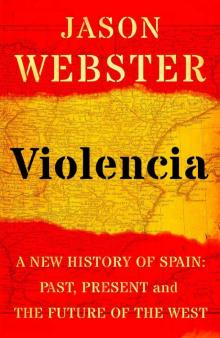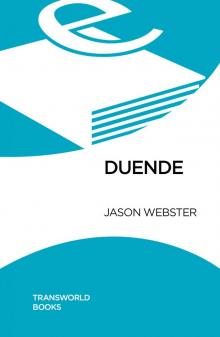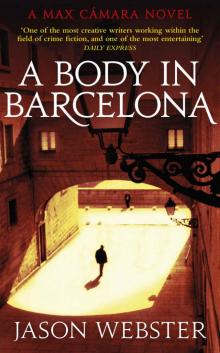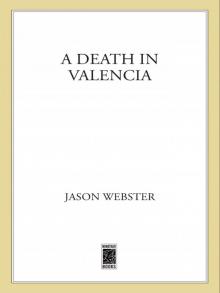- Home
- Jason Webster
Violencia Page 4
Violencia Read online
Page 4
Altamira man – and his many cousins in northern Spain and south-eastern France – was clearly sophisticated, not only as a painter, but also as a thinker. If his ancestors at Atapuerca were capable of understanding the symbolism of throwing a stone axe into a pit full of the dead, then many hundreds of thousands of years later, at Altamira, symbols of extraordinary beauty and complexity were being fashioned on a regular basis.
And so what were the paintings for?
Theories, as you might imagine, abound. But magic and a spiritual element are often cited as being part of their meaning, which seems a safe bet. Perhaps an element of shamanism was involved, the invoking of spirits, communication with other worlds. In short, a kind of mysticism.
Two cave complexes, two very different atmospheres, which give a glimpse of two distinct sides of the character of early Spaniards.
MEN FROM THE EAST
Archaeological Spain flows into mythological Spain, which flows, gradually, into history.
Legends about the origins of human communities on the Peninsula have traditionally centred around two figures, both sons of the eastern Mediterranean brought to the west on their travels. As we shall see, their stories form a pattern which is repeated several times over Spanish history.
The first, the mythological founder of Iberia according to ancient sources, including St Isidore of Seville (d. 636 AD), was the biblical Tubal (not to be confused with Tubal Cain, who was a descendant of Cain). Tubal was the son of Japheth, son of Noah. At some point after the Flood, when Noah’s offspring were repopulating the world, Tubal and his family landed on the northwest Spanish coast.1
Tubal established a dynasty of kings, naming the country after his eldest son Ibero, who also gave his name to the River Ebro. He in turn was followed by his descendants, including one Tago (after whom the River Tagus is named) and Beto (from which came Betis, the old name of the River Guadalquivir).
Tubal is curious for he appears to have established a new community not only in Spain but also in Siberia (capital Tobolsk, supposedly in his honour) and in the Caucasus. In an interesting echo, ancient Georgia – or at least the eastern half of it – used to be called Iberia, and the mythical character who established the country was none other than Tubal. It seems far-fetched to put this down to mere coincidence, as some insist. So what might be the connection?
In a Georgian context, Tubal is often seen as synonymous with a post-Hittite Anatolian state called Tabal. This area was populated by, among others, a tribe known as the Tibareni, whose name may derive from Noah’s grandson. The Tibareni are thought to be one of the peoples who founded metallurgy, which grew up on the southern shores of the Black Sea during the Neolithic era. Did these metalworkers then travel as far as ancient Iberia with their new technology, perhaps in search of tin, an essential ingredient for making bronze? That ancient peoples were quite mobile is now more accepted than it once was, so early Georgians landing on the shores of the far western Mediterranean, having first crossed through the Bosphorus and down the Aegean Sea, is not so preposterous a claim.
But back to Tubal in Iberia, who also, according to legend, put his stamp on the place by founding the towns of Tafalla, Vélez-Málaga, Tudela and Úbeda in Spain, and Setúbal in modern Portugal, suggesting a wide extension over the Peninsula. His descendants continued as kings for many generations, until we reach the last two, Gárgoris and Hábis. Stories about these two kings are considered the first truly Spanish legends, as opposed to imports from other Mediterranean cultures.
Gárgoris introduced honey collecting to the peoples of ancient Iberia. He had a beautiful daughter and with her had a son, Hábis. Many attempts were made to do away with the child, fruit of an incestuous relationship, but to no avail – the baby refused to die, despite being exposed in the wild and even thrown out to sea. Eventually, sensing that there was something exceptional about the boy, Gárgoris accepted him, naming him his heir. In due course Hábis became king, introducing agriculture to the Peninsula through the use of yokes on oxen. He also divided society into seven social groups (or cities), and his line continued for many generations thereafter.
This first Spanish myth carries with it one of the main patterns running through the country’s history, that of one version of the country trying to smother or annihilate the other: Gárgoris tries to rid himself of his son, Hábis. But the tale also holds the seed for the solution to this seemingly intractable problem: the ‘other Spain’ can never be got rid of, and so must be accepted; there must be mutual acknowledgement and toleration, and by doing this Spain can take great strides forward: Hábis as king goes on to bring new technologies and civilisation to the Peninsula. The structure of Spanish history is almost all there in this story, but the lesson from it has rarely been learned, as we shall see.
Hábis’s Neolithic society has been linked with the historical culture, or city, of Tartessos.
Tartessos is Spain’s Troy, existing in a twilight zone between myth and history. That a culture of this name existed in the late Bronze Age and early Iron Age in south-west Spain is not in doubt. But its exact location is unknown: no city of that name has ever been discovered, leading some to argue that Tartessos described a civilisation rather than a specific place.
Archaeological evidence for the existence of Tartessos – either as a city or as an area – exists in abundance, including the remains of ancient settlements, pieces of gold jewellery, and scraps of a written language which was read from right to left (and which has yet to be deciphered). There are also references to Tartessos in ancient sources: it was mentioned by Herodotus and Pliny as well as many others. Ephorus of Cyme, a Greek historian and contemporary of Alexander the Great states clearly that the city of Tartessos lay between the two mouths of a river of the same name which had previously been called the Betis.
So the city of Tartessos, if it existed, probably lay near to where the Guadalquivir flows into the Atlantic, to the north of Cádiz, in what is today the National Park of Doñana, a wetland and protected nature reserve.
Which brings us to Atlantis, another lost city of the ancient world, located by Plato beyond the Strait of Gibraltar, not far from Cádiz . . .
Was Tartessos Atlantis – that is, if Atlantis existed at all? Some support this idea. An early proponent of the theory was Spanish seventeenth-century historian Juan Pellicer de Ossau. More recently, in the early twentieth century, German archaeologist Adolf Schulten suggested the same. The theory was taken up by several others in the early twenty-first century, but so far exploration of the Doñana area using modern archaeological techniques has revealed nothing.
It is possible, however, that stories linking the myth of Atlantis with ancient Iberia persisted for many centuries after Plato, possibly inspiring a new name for the Peninsula, as we shall see in a subsequent chapter.
But back to Tubal and his dynasty. Gárgoris and Hábis are the last mythological kings of Tartessos. The first was Gerion. And here is where a second, and hugely important, mythological character arrives on Spanish shores: Heracles/Hercules.
The parallels between Heracles and Tubal are striking: neither is a god or prophet in his own right, but both are connected to another greater than themselves – Heracles is a demigod, son of Zeus; Tubal the grandson of God’s favourite, Noah. Both are characters belonging originally to traditions emerging from the eastern Mediterranean; and both reach Spain and leave an indelible mark, founding cities and civilisations in their wake. Heroes who connect the country with a powerful culture from the East and then change the course of Spanish history. The pattern is repeated several times.
Being a legend, Heracles steps in and out of the mythological ‘chronology’. His first appearance is during the Tenth and Eleventh of his celebrated Tasks, when he tames Gerion’s cattle, and then steals the prized apples from the Gardens of Hesperides. Both events take place, supposedly, in Spain.
Not only that, but Heracles created the very Strait between Spain and North Africa which for so long bor
e his name.
There are several versions of the tale:
The Ancient Greeks believed that the two continents were originally much further apart, and that Heracles brought them closer together, thereby making the passage narrower and shallower to prevent Atlantic sea monsters from entering the more placid waters of the Mediterranean.
The Romans told a story in which Africa and Europe were linked by a mountain during the hero’s lifetime – there was no Strait – and that their Hercules cut a way through it with his bare hands, thus opening the way for the Atlantic to flow into the Mediterranean. The remains of the mountain were left on either side of the newly created channel. These were the ‘Pillars of Hercules’ – known at the time as Calpe, to the north, and Abilyx, to the south.
But what really were the ‘pillars’ that Hercules left behind? The two peaks on either side of the Strait? Or actual columns that he himself constructed?
The ancient Iberians insisted that the real pillars were not mountains at all, but structures at the temple of Hercules in Cádiz.2 According to legend, the real founder of Cádiz was this same Hercules. The temple marked his tomb (lying underneath today’s cathedral). So important was this site that, despite its being at the far edge of the world, both Hannibal and Julius Caesar journeyed to visit it. Caesar broke down and wept with emotion on entering.
Along with Cádiz, legends also attribute the founding of Barcelona and Mérida to the demigod, along with a palace which bore his name in Toledo. In addition, a Roman lighthouse in La Coruña, on the far Galician coast, dating from at least the first century AD and measuring almost 60 metres high, is commonly known as the Tower of Hercules. As well as being the only functioning Roman lighthouse still in existence, it links Spanish mythology with the Irish, for it is said that from here Ith, son of the mythical King Breogan, first spotted distant Ireland, eventually sailing and settling there.
Perhaps the most interesting stamp that Heracles made on the Peninsula lay in the ancient road that ran from Spain through southern France and into Italy, the Via Heraklea. The exact route this took is not known. Did it hug the Atlantic coast and end at Cartagena? Did it extend beyond and over towards Cádiz? Or was it, as author Graham Robb argues, a straight line which ran from the Cape of St Vincent at the far end of the Algarve to the Alps, following the course of the sun on the Summer Solstice? Whichever path it followed, it’s interesting to note how closely Spain was associated with Heracles. A hero who originates in a different culture (or cultures: the Phoenicians had their own version of the demigod, Melkart) at the other end of the Mediterranean becomes synonymous with ancient Iberia. The Via Heraklea, an important route in ancient Europe, is so called precisely because it leads into Spain.
Which brings us to Santiago. Like Tubal and Heracles, St James originates in the eastern Mediterranean. Like them he is not a god or prophet in his own right, but very close to one (even being related to Jesus, as the various Jameses of the New Testament were frequently confused with one another by storytellers, St James the Great sometimes morphing with Jesus’s brother of the same name). Like them, he brings change, ushering in a new age for the Peninsula. And like Heracles, he leaves behind a road which carries his name, a route which crosses the Pyrenees into France and thence to the heart of Europe.
Tubal–Heracles–Santiago – heroes from the East who shape and transform Spanish culture.
As we shall see, more like them are to come.
1 The stories of Santiago’s body arriving in Spain have the Apostle’s boat touching shore in a similar area: when the rest of the Peninsula was under Islamic control, it made sense for these stories to create a link between the Christian-controlled north and the biblical world.
2 The two columns are part of the Spanish coat of arms to this day, and are the origin of the two vertical lines in the American dollar sign, having been borrowed from the Spanish ‘pieces of eight’, the common currency in the Atlantic following the discovery of the New World. They have subsequently been used in all major currency symbols.
ITALIAN SPAIN
HISPANIAE – THE ROMAN SPAINS
The Romans’ influence began to spread in Iberia – a land they called Hispania – as early as 281 BC. They understood the Peninsula as a geographical entity, not as a political whole. As with other lands which they conquered, during their seven-hundred-year presence they divided their territories there into a number of provinces.
During the earlier period, when Roman territory was limited to the eastern and southern coasts, the newcomers drew a line roughly where Murcia lies today. The northern part was referred to as ‘this Spain’ (Hispania citerior) and the southern as ‘that Spain’ (Hispania ulterior – the one further away from Rome).
As their control over the Peninsula slowly spread, so did the number of provinces.
By 27 BC, and with the conquest of Spain almost completed, the Emperor Augustus divided the Peninsula into three parts. ‘This Spain’ became Hispania tarraconensis, named after its main city, Tarragona. ‘That Spain’ was subdivided: what is roughly today’s Andalusia became Hispania baetica, while the western areas were known as Hispania lusitania (to this day, the Spanish sometimes use the word luso to describe things Portuguese).
But by the third century even three provinces were deemed insufficient, and a further two were added, with Tarraconensis split roughly north and south, the southern half named Cartaginensis, and northern Lusitania turned into its own province of Gallaecia – comprising what is roughly today’s Galicia. Things continued in this way until the crumbling of the Roman Empire and the arrival of Germanic tribes in the fifth century.
Three, five, seven, nine . . . Over the centuries the Peninsula would unite and redivide into many different areas and ‘countries’. But the final partition into five by the Romans is echoed today both in the number of official languages, and in the Spanish coat of arms, which combines the emblems of the five kingdoms that made up Spain during the High Middle Ages: the castle of Castile; the lion of León (named after the Roman VII Legion stationed there, not after any wild beast . . .); the chains of Navarre; the red and yellow stripes of Aragon (from St George wiping blood off his fingers after killing the dragon); and the pomegranate of Moorish Granada (the English ‘pomegranate’ meaning ‘fruit of Granada’, hence ‘grenade’, ‘grenadiers’, etc.).
Five Spains . . . Roman rule over the Peninsula reflected its essentially fragmented nature. And it’s interesting to note today how little the Roman part of Spanish history figures in the collective Spanish imagination. The Latin-based languages are the most significant legacy from the period, but the Romans are very much seen as ‘them’, not ‘us’. And whereas the British will give a sense of how old something is by describing it as ‘being there since the Romans’, the equivalent phrase in Spanish evokes a later time: desde los moros – ‘since the Moors’.
Roman Hispania is a key building block in the construction of Spain, giving the Peninsula the name by which it is known today – ‘Hispania’ – becoming, over time, ‘España’, Spain.1 And yet the paradox is that at the same time it isn’t, well, Spain.
Nonetheless, the Roman period is significant in that it sees the beginnings of both the Cassandra complex which becomes Spain’s blessing and curse over the centuries, and of a pattern of forgetting the past in order to forge new ideas about national identity.
As elsewhere, the Roman Empire brought engineering, road-building, and the benefits of their advanced culture, as seen most magnificently at Segovia, whose aqueduct, built around 100 AD, still astounds today with its scale and ambition. The cities of Mérida and Tarragona are home to impressive Roman archaeological remains. In return, Spain gave to Rome some of its most important sons: the Emperors Trajan, Hadrian, Marcus Aurelius and Theodosius were all of Hispanic origin, as was Martial, and Seneca, who was born in Cordoba.
And yet this time in Spanish history is not a glorious example of the Pax Romana, of local peoples adapting to their new enlightened rulers af
ter a period of token resistance. Nor particularly does it demonstrate the famed efficiency of the Roman military. For centuries, in fact, Hispania was a far-off western land which was essentially a theatre of war.
It took Julius Caesar eight years to conquer Gaul. Roman legions covered Britannia in about forty years. By comparison, Hispania was not completely conquered by the empire for two hundred years. That it took so long can perhaps be explained by the difficult mountainous terrain, or perhaps by the warlike locals, referred to by Virgil as the ‘restless Iberians’, whose short swords, especially the falcata, were made with particularly strong steel and very much feared by Roman legionaries. But when you compare this with the ten years that it took the Moors to conquer the same territory in the eighth century, you begin to wonder.
Rome’s initial contact with the Peninsula began in the context of the Punic Wars. Much of the southern and eastern coasts had been colonised by the Carthaginians (following in the footsteps of their predecessors, the Phoenicians). Once the Romans had pushed them out of Corsica, Sardinia and other territories closer to Rome, the Carthaginians saw Iberia as an important toehold on northern Mediterranean shores. The Greeks, however, fearful of further Carthaginian expansion northwards up the Iberian coastline towards their trading colonies, sought defensive alliances with Rome. The scene was set for further conflict, and the most celebrated of the Punic Wars, the Second, began over the town of Sagunto, a hilltop castle and natural defensive position just a mile inland from the sea2 on Spain’s eastern shore. The Carthaginians, now led by Hannibal, besieged and took it, slaughtering many of its inhabitants. The Romans, in turn, insisted their enemy had broken a treaty agreement, and war was declared.
Hannibal almost destroyed Rome in the subsequent campaign. But his eventual defeat in 206 BC opened the way for the Romans to become the dominant power in the Mediterranean. In her first Cassandra-like moment, Spain had therefore acted as the starting point for what would turn into six hundred years of an imposing empire and civilisation which shaped the Western world.

 Violencia
Violencia Or the Bull Kills You
Or the Bull Kills You The Killing of El Niño Jesús
The Killing of El Niño Jesús The Spy with 29 Names
The Spy with 29 Names Duende
Duende Guerra
Guerra Sacred Sierra
Sacred Sierra A Body in Barcelona: Max Cámara 5
A Body in Barcelona: Max Cámara 5 Fatal Sunset
Fatal Sunset A Death in Valencia
A Death in Valencia Blood Med
Blood Med Andalus
Andalus